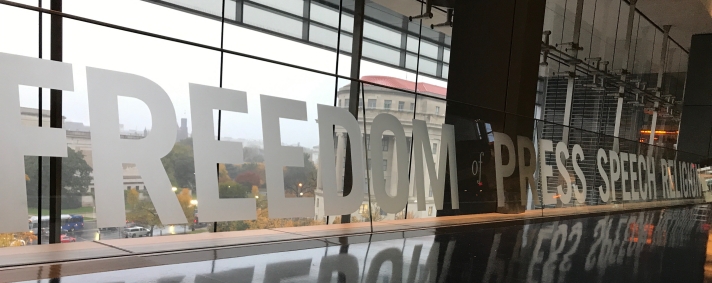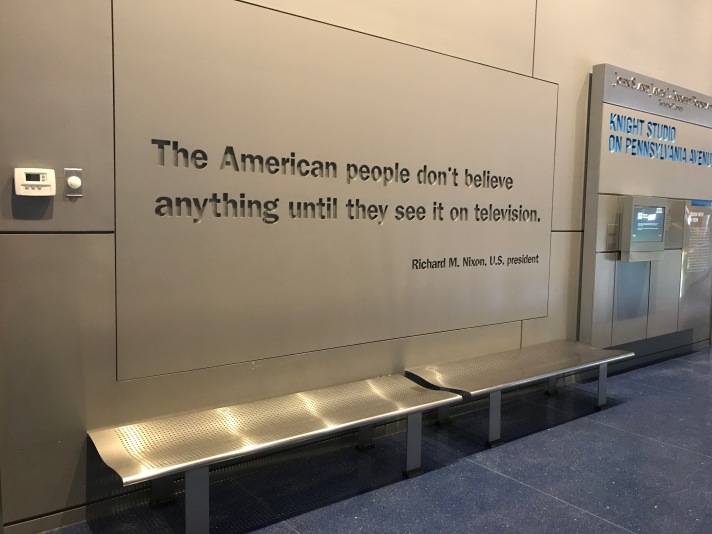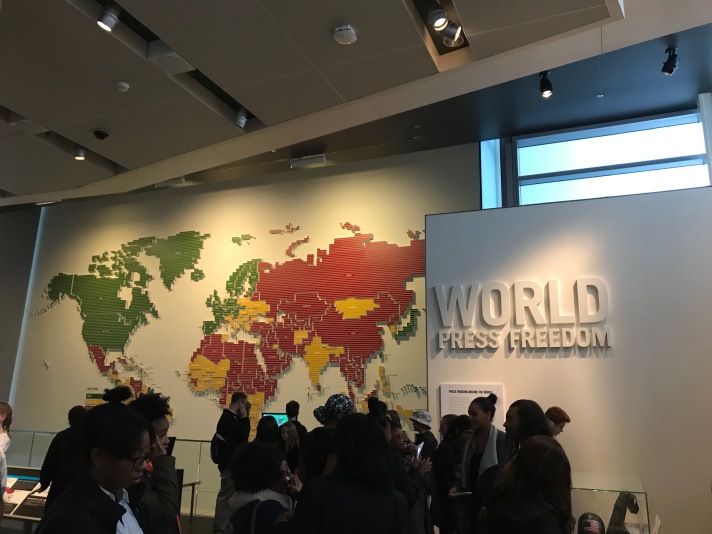On November 7, 2017 my NewsVision capstone thesis class took a field trip to the Newseum in Washington, D.C. It was a terribly rainy day–the kind that makes you want to stay inside and curl up in a blanket with a book or movie. But, we as journalists, have a job and that job is to never rest.
Let me start by saying that I absolutely adore the Newseum. The first time I ever explored it, I was with Spotlight News, a student-run news organization at Howard University. The trip was scheduled for maybe a week after I had officially changed my major from public relations to broadcast journalism in 2015. Walking into the building felt like God’s reassurance that I was doing the right thing. From the giant multi-paneled screen in the main lobby showing news from all over the world, to the newspapers lining the sidewalks representing every major headline printed in the country that day, I felt like I was at home and that my decision was a good one.
Coming back with my NewsVision class in 2017 felt like a whole new experience. Although many of the exhibits hadn’t changed, my mindset and outlook had. The way I perceived things now that I knew more about what they meant definitely had an impact on my view this time around.

For example, the importance of the Freedom of Press has never been so crucial to me until the administration of the 45th president of the United States required me to defend my integrity in storytelling against the fallacy of “fake news”. I’ve noticed that the president often times also refuses to let media in the room during some of his important briefings. As a journalist, this practice is pretty concerning.

Former President Richard M. Nixon once said, “The American people don’t believe anything unless they see it on television.” Granted, most people in today’s day and age get their news from social media sites such as Twitter. It’s still important, nonetheless, for professional journalists to be able to step in and give the unbiased facts. The people have a right to know what’s going on and the First Amendment protects that right by giving the press freedoms to write what is necessary.

America is actually one of few countries in the world with complete press freedom as indicated by this life-size graph. Every country painted green has total and complete freedom, countries in yellow are limited and the countries in red have absolutely none. It’s rather trivial for one person to think they can change the constitution like that. Two years ago, I was certainly not thinking about how the first amendment could ever be compromised. But, that just goes to show why it is important to re-see some things and reflect on them twice.
Another perfect example would be the Civil Rights Movement exhibit. Two years ago, Spotlight spent what felt like an hour looking through every picture, every video, every headline and every caption. But, this time, I noticed a kiosk that I hadn’t seen before. It was a little booth stationed right on the outside of a theatre showing an informational video dedicated to John F. Kennedy and his wife. In this particular kiosk, there were pages of videos about notable figures speaking on different things that happened during the Civil Rights Movement. I scrolled through the thumbnails and settled on a video about the assassination of Dr. Martin Luther King Jr.
What made this video so special to me was the fact that the older gentleman being interviewed was so prolific in his storytelling. He told the world about the day MLK Jr. was shot. He recounted every second and spoke of the emotions of each individual in a sort of stream-of-consciousness. I had become so engrossed in his story that I didn’t realize my class had collectively moved on to another exhibit. When the video ended, I looked up and realized that I was the only person in that particular corner of the universe, huddled over a kiosk with burning, watery eyes.
Not many exhibits get me going, especially not when I’m in a large group because I feel like I can’t move at my own pace. But this exhibit, this kiosk, this video allowed me to forget the outside world for a second and stand on the balcony of the Lorraine Motel (my middle-namesake) searching wildly in the air for the direction in which the bullet came and pierced the chest of one of the greatest leaders of the time. I felt the panic, I felt the betrayal and I felt the fear of what was to come next. But then, as I said, the video ended and I was back in 2017 at the Newseum huddled over a kiosk “with burning, watery eyes”.
As a journalist, one of the proudest moments in my field of profession, in my opinion, was the accurate and well-fought over coverage of the Civil Rights Movement. In many of my classes here at Howard University, I’m taught the truth about our nation’s history. Black people were only ever included in the news when they did something wrong. It helped paint a very distinct image that still plays a role in the stereotypes and discrimination that Black people face today. But something about the Civil Rights movement changed some of what White America knew about fair and just representation in the media. Black journalists, who had been covering Black topics since their inception, were well on their way in covering what was happening in the South with riots, race wars and police brutality. When word of the peaceful protests and mistreatment of Blacks in the streets got to be too much to hide, the White newspapers knew they couldn’t continue to ignore it. Many White companies went out and hired notable Black journalists to cover the issues as a result of this sudden realization that every narrative is indeed important and interesting and should be represented equally. As the US Representative John Lewis’ voiceover stated in the last video that our class watched before parting ways from the Newseum, “If it hadn’t been for the media, … the civil rights movement would have been like a bird without wings, a choir without a song.”
The more I think about that quote, I wonder: How much has really changed in terms of the media’s coverage of black people during the 1960s to 2017?
Featured above are two pictures that I took at an informational kiosk in the Civil Rights Movement exhibit. The first is coverage from the March on Washington in 1963, the second is coverage from Ferguson after the murder of unarmed teenager Michael Brown in 2014. Both showed Black people peacefully expressing their unhappiness with the way they are treated in America, both also showed Black people being harassed by people of differing races and some by the police. The biggest difference that I was able to note in the two stories was that black people were interviewed in the Ferguson story. This realization gave me an immediate answer to my original question. In the 1960s, we finally gained the right to have our stories told. As the years passed leading up to 2014, we finally gained the right to tell them ourselves.
Want to take your own trip to the Newseum?
Address: 555 Pennsylvania Ave., N.W., Washington, DC 20001
Website: http://www.newseum.org
Phone: (202)292-6100
Email: info@newseum.org

